Friday, July 6th 2012

GIGABYTE Launches World's First Fully Certified Dual Port Thunderbolt Motherboards
GIGABYTE TECHNOLOGY Co. Ltd., a leading manufacturer of motherboards and graphics cards, today announced the latest GIGABYTE 7 series motherboards, the very first to offer fully certified dual onboard Thunderbolt ports. Capable of connecting up to 12 devices plus 3 digital displays simultaneously, with breathtaking data transfer speeds that can transfer 1 TB of data in only five minutes, GIGABYTE Thunderbolt motherboards offer the fastest connection interface ever on the desktop PC.
GIGABYTE Thunderbolt motherboards allow users to daisy chain up to 12 devices simultaneously via an incredible bi-directional 10 Gbps data pipeline that includes both PCIe and DisplayPort traffic. GIGABYTE Thunderbolt motherboards redefine desktop PC connectivity to make it far easier to connect multiple high speed storage devices and HD displays to your PC than ever before."It's easy to see how our unique dual port Thunderbolt implementation simply offers more," commented Henry Kao, Vice President of GIGABYTE Motherboard Business Unit. "We're the only motherboard vendor currently offering DIY PC builders the absolute maximum in terms of device connectivity."
"Thunderbolt technology represents a leap in performance and simplicity for media creators and entertainment enthusiasts," says Jason Ziller, Intel's director of Thunderbolt marketing. "We are pleased to be working with GIGABYTE as they bring the first dual Thunderbolt port motherboard to market. It's a great example of what Thunderbolt makes possible."
GIGABYTE Dual Thunderbolt motherboards open up a wealth of new possibilities regarding high-performance storage devices. GIGABYTE has worked closely with several leading device partners, including Promise Technology, LaCie, BlackMagic, Western Digital, Seagate, Elgato, CalDigit and cable manufacturer Sumitomo:
"Working with GIGABYTE has been very exciting," said Kosta Panagos, Director of Creative Marketing, at CalDigit. "GIGABYTE's new line of Intel 7 series motherboards featuring dual Thunderbolt ports, will usher in a new era of flexibility to the PC platform. It is also a perfect match with CalDigit's new T1 and T2 Thunderbolt drives which provide professional level performance on all platforms at consumer prices, a feat that was previously unattainable, thanks to GIGABYTE and Thunderbolt technology."
GIGABYTE's new dual port Thunderbolt motherboards are an exciting innovation, giving incredible performance and are perfect for video and film professionals using Thunderbolt and the PC," said Grant Petty, CEO, Blackmagic Design. "Customers using our wide range of Thunderbolt devices will now be able to choose to work in whatever format they need, giving them the flexibility to build whatever production and post production workflow they need.""In line with GIGABYTE and its dual on board Thunderbolt ports, WD's My Book Thunderbolt Duo offers dual Thunderbolt ports for amazing creative flexibility while allowing daisy-chaining of up to six My Book Thunderbolt Duo drives or other high performance peripherals for fast and efficient workflow," said Craig Davis, Director Sales & Marketing, Retail Division, Western Digital Asia Pacific & Japan Region.
"Thunderbolt technology is a fantastic way to deliver both data and display via one interface. It provides unparalleled performance and plenty of flexibility," said Leo Paskin, Product Marketing Manager at Seagate. "With the ability to daisy chain up to 12 devices on GIGABYTE's new dual port Thunderbolt motherboards, you can turn a desktop PC into a central device hub by plugging in a single cable!"
"As the first Intel certified cable vendor, Sumitomo is delighted to see GIGABYTE bring the first dual port Thunderbolt motherboard to market, creating the ultimate connectivity for desktop PCs," commented Motoi Matsuo. "These new Thunderbolt motherboards are also the perfect fit for Sumitomo's exclusive high speed 20m optical cables."
"Thanks to their dual Thunderbolt ports, Gigabyte's new 7 series motherboards deliver unbeatable flexibility", says Adam Steinberg, Vice President Marketing at Elgato. "The unique dual port feature enables users to combine multiple portable Thunderbolt devices like the powerful Elgato Thunderbolt SSD."
"LaCie is pleased to see GIGABYTE announce Thunderbolt technology on their lasted motherboards," said Erwan Girard, Professional Business Unit Manager, LaCie. "The time is now for demanding PC users, especially digital content creators, to experience the unprecedented speeds and advantages enabled by Thunderbolt Technology. The desire for computers and peripherals to keep up with their work flow is a concern of the past."
Dual Thunderbolt - Fast, Flexible and Simple Connectivity for your Motherboard
GIGABYTE Thunderbolt motherboards are the first to be certified by Intel featuring dual Thunderbolt ports directly on the motherboard back panel I/O, with each Thunderbolt port supporting a maximum data transfer speeds with simultaneous bi-directional data transfer at speeds of up to 10 Gbps - this means you can transfer a full HD 1080p movie in under 30 seconds.
GIGABYTE's dual port Thunderbolt implementation ensures the absolute maximum potential connectivity, with support to connect up to 12 individual devices simultaneously, with each port offering full 10 Gbps bandwidth.Thunderbolt combines both DisplayPort and PCI Express protocols over a single cable so that users can connect a multitude of device types in tandem with HD streaming video and 8-channel audio, simultaneously in one specially developed cable. Users can also enjoy improved flexibility by 'daisy-chaining' several devices while still enjoying low latency and industry-leading data transfer speeds.
GIGABYTE Thunderbolt Motherboards Models
Dual Thunderbolt Ports are featured on the following GIGABYTE motherboard models:Ultra Durable 5
The GIGABYTE Z77X-UP5 TH and Z77X-UP4 TH both employ award winning GIGABYTE Ultra Durable 5 technology that includes high current capable components for the CPU power zone including IR3550 PowIRstage ICs from International Rectifier, 2X Copper PCB and high current Ferrite Core Chokes rated up to 60A, which together are able to deliver up to 60°C cooler temperatures than traditional motherboards. Featured on a range of new motherboards based the Intel X79 and Z77 Express Chipsets, GIGABYTE Ultra Durable 5 technology is the next evolution in quality motherboard design.
GIGABYTE Thunderbolt motherboards allow users to daisy chain up to 12 devices simultaneously via an incredible bi-directional 10 Gbps data pipeline that includes both PCIe and DisplayPort traffic. GIGABYTE Thunderbolt motherboards redefine desktop PC connectivity to make it far easier to connect multiple high speed storage devices and HD displays to your PC than ever before."It's easy to see how our unique dual port Thunderbolt implementation simply offers more," commented Henry Kao, Vice President of GIGABYTE Motherboard Business Unit. "We're the only motherboard vendor currently offering DIY PC builders the absolute maximum in terms of device connectivity."
"Thunderbolt technology represents a leap in performance and simplicity for media creators and entertainment enthusiasts," says Jason Ziller, Intel's director of Thunderbolt marketing. "We are pleased to be working with GIGABYTE as they bring the first dual Thunderbolt port motherboard to market. It's a great example of what Thunderbolt makes possible."
GIGABYTE Dual Thunderbolt motherboards open up a wealth of new possibilities regarding high-performance storage devices. GIGABYTE has worked closely with several leading device partners, including Promise Technology, LaCie, BlackMagic, Western Digital, Seagate, Elgato, CalDigit and cable manufacturer Sumitomo:
"Working with GIGABYTE has been very exciting," said Kosta Panagos, Director of Creative Marketing, at CalDigit. "GIGABYTE's new line of Intel 7 series motherboards featuring dual Thunderbolt ports, will usher in a new era of flexibility to the PC platform. It is also a perfect match with CalDigit's new T1 and T2 Thunderbolt drives which provide professional level performance on all platforms at consumer prices, a feat that was previously unattainable, thanks to GIGABYTE and Thunderbolt technology."
GIGABYTE's new dual port Thunderbolt motherboards are an exciting innovation, giving incredible performance and are perfect for video and film professionals using Thunderbolt and the PC," said Grant Petty, CEO, Blackmagic Design. "Customers using our wide range of Thunderbolt devices will now be able to choose to work in whatever format they need, giving them the flexibility to build whatever production and post production workflow they need.""In line with GIGABYTE and its dual on board Thunderbolt ports, WD's My Book Thunderbolt Duo offers dual Thunderbolt ports for amazing creative flexibility while allowing daisy-chaining of up to six My Book Thunderbolt Duo drives or other high performance peripherals for fast and efficient workflow," said Craig Davis, Director Sales & Marketing, Retail Division, Western Digital Asia Pacific & Japan Region.
"Thunderbolt technology is a fantastic way to deliver both data and display via one interface. It provides unparalleled performance and plenty of flexibility," said Leo Paskin, Product Marketing Manager at Seagate. "With the ability to daisy chain up to 12 devices on GIGABYTE's new dual port Thunderbolt motherboards, you can turn a desktop PC into a central device hub by plugging in a single cable!"
"As the first Intel certified cable vendor, Sumitomo is delighted to see GIGABYTE bring the first dual port Thunderbolt motherboard to market, creating the ultimate connectivity for desktop PCs," commented Motoi Matsuo. "These new Thunderbolt motherboards are also the perfect fit for Sumitomo's exclusive high speed 20m optical cables."
"Thanks to their dual Thunderbolt ports, Gigabyte's new 7 series motherboards deliver unbeatable flexibility", says Adam Steinberg, Vice President Marketing at Elgato. "The unique dual port feature enables users to combine multiple portable Thunderbolt devices like the powerful Elgato Thunderbolt SSD."
"LaCie is pleased to see GIGABYTE announce Thunderbolt technology on their lasted motherboards," said Erwan Girard, Professional Business Unit Manager, LaCie. "The time is now for demanding PC users, especially digital content creators, to experience the unprecedented speeds and advantages enabled by Thunderbolt Technology. The desire for computers and peripherals to keep up with their work flow is a concern of the past."
Dual Thunderbolt - Fast, Flexible and Simple Connectivity for your Motherboard
GIGABYTE Thunderbolt motherboards are the first to be certified by Intel featuring dual Thunderbolt ports directly on the motherboard back panel I/O, with each Thunderbolt port supporting a maximum data transfer speeds with simultaneous bi-directional data transfer at speeds of up to 10 Gbps - this means you can transfer a full HD 1080p movie in under 30 seconds.
GIGABYTE's dual port Thunderbolt implementation ensures the absolute maximum potential connectivity, with support to connect up to 12 individual devices simultaneously, with each port offering full 10 Gbps bandwidth.Thunderbolt combines both DisplayPort and PCI Express protocols over a single cable so that users can connect a multitude of device types in tandem with HD streaming video and 8-channel audio, simultaneously in one specially developed cable. Users can also enjoy improved flexibility by 'daisy-chaining' several devices while still enjoying low latency and industry-leading data transfer speeds.
GIGABYTE Thunderbolt Motherboards Models
Dual Thunderbolt Ports are featured on the following GIGABYTE motherboard models:Ultra Durable 5
The GIGABYTE Z77X-UP5 TH and Z77X-UP4 TH both employ award winning GIGABYTE Ultra Durable 5 technology that includes high current capable components for the CPU power zone including IR3550 PowIRstage ICs from International Rectifier, 2X Copper PCB and high current Ferrite Core Chokes rated up to 60A, which together are able to deliver up to 60°C cooler temperatures than traditional motherboards. Featured on a range of new motherboards based the Intel X79 and Z77 Express Chipsets, GIGABYTE Ultra Durable 5 technology is the next evolution in quality motherboard design.
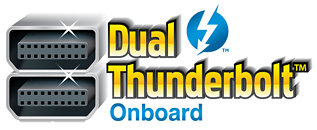
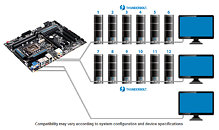
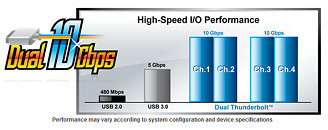



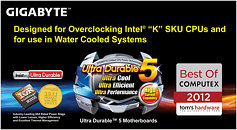
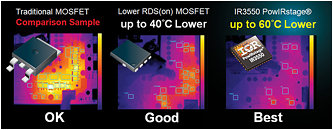
56 Comments on GIGABYTE Launches World's First Fully Certified Dual Port Thunderbolt Motherboards
No bandwidth is reserved for graphics, however, IF you use a DisplayPort monitor, a chunk of the bandwidth will be used for the display data. Otherwise you have access to the full 20Gbps.
As for where Gigabyte gets the bandwidth from, well, just like MSI, they're connecting to the chipset, as the DSL3310 and the DSL3510 both uses four lanes on bandwidth, except the DSL3310 only gives you half of the available bandwidth ;)
And as per the post above, they use a PLX bridge for the other chipset connected third party controllers.
Time to read up on your Thunderbolt tech mate :D
Unless you had SSD's in the MAC's and a decent server to get the image off it would be point less.
Is there any practical use for thunderbolt? other than display?
There are some pretty nifty video capture/editing solutions from BlackMagic Design and a few others as well as some high-end audio creation hardware.
I guess it depends on what you do, but for your average consumer, no so much.
Burn
A thunderbolt motherboard, if you used direct 4X lanes from the PCH, would have 4 extra PCI-E lanes. So at best you could do 1 NIC, Maybe an extra SATA controller or USB 3.0, as the native PCH only has 4 of them, so there goes another. And then depending on how the motherboard maker feels, they could toss in a PCI-E to PCI bridge and then have a PCi slot. However then you have to realize all of those 1X slots need their own PCI-E lanes as well! Holy crap right? There goes any chance of a 4X slot direct to the PCH, any chance of a PCI slot, any chance for more USB and SATA at the same time, as the issue also is that the 1X slots need their own lanes(of course most boards put them on a switch).
The whole thing about how chips like the PLX8747 and NF200 are making magical lanes for the user is kind of funny considering most everyone uses a router which uses the same technology/concept and hooks up maybe 1 or two computers to it at minimum. The PLX in that case would be able to consolidate lanes and bandwidth to where it is needed, it isn't just stagnant, you gotta realize PLX bridges cost money. However using the PLX would allow for more controllers for things like 1394A, USB 3.0, all the extra SATA, and NIC(s), maybe a special audio chipset that requires a PCI-E lane like a creative CA0132 or CA20K2. Basically more features. Also you cannot ignore the fact that many very high-end boards rely on PLX bridges to provide all the connectivity.
IMO I don't know how to react to a technology which Intel brings out yet doesn't integrate a connection for directly into the PCH. In my opinion Intel should have provided an extra 4X PCI-E lanes directly from the CPU, such as was on X79 for SAS which was removed. Intel is greedy with PCi-E lanes, no reason everyone should suffer.
BTW it isn't like MSI doesn't use PLX bridge such as the one used here, you guys use one on your X79 BigBang X-Power II (which is a great board BTW)
It does two major things...
1) It acts as an extension of the PCI Express bus, so you can extend it outside of the computer. For example lets say you had a monitor and on that monitor you had four USB 3.0 ports, a Gigabit Ethernet port, 2 eSata ports, and a TV Turner. It could do all of that plus point #2 using just ONE cable.
2) It can do video as well as all the stuff on point #1. So the thunderbolt port is actually a mini display port that can be hooked up to a monitor (such as the monitor on point #1 above, but do all of this with just one cable).
It's a daisy chained connection, so if you have one thunderbolt port you can plug it in and then another one to extend out to something else.
If you were to look into the Device Manager you would see a ton more devices that you don't even have on your computer, because it actually extends out the PCI Express bus outside of your own computer.
With USB 3.0, it's fast, but thunderbolt is much faster because it has to carry a whole bus + the highest video port on a modern computer. USB 3.0 just carries one cable for one device which can be a lot of cables.
So, in reality it's very much worth it and it is a standard that has been created by Intel and adopted by Apple and the rest of the industry as well.
The downside right now is price, the cables are expensive and the ports are as well.
Intel's Thunderbolt is available in copper wire, but will go to optical in the future.
I hope this helps, at least from a standard point of view this has nothing to do with Firewire. Firewire was mainly created from Apple and it was mainly for Video and that is all, well USB got faster and started to do video as well and the port became redundant.
you cant hook up a graphics card over USB 3.0.
For $650 I'd be sitting pretty with an PCIe x8 SAS controller and external 24-bay case connected at 24Gbps ready to accept drive after drive. When filled, time to chain another, then another, and so on until I reach the controller's limit.
Even where it's useful it's hard to get enthusiastic about it. I mean really, "the versatility of vendor-neutral docking stations realized in our lifetimes" is a hardly a rallying cry. Thunderbolt isn't bad, but when someone asks "Where do we go from here?" you shouldn't stop at "Let's combine PCIe and DP".
I have been using computers since 1982 and I just built a new ivy bridge with thunderbolt so that it's built for the future and I don't have as many ports on the back as I want and with this I can add a lot of stuff with one cable. I don't see where the problem is.
If you want a 4k HD webcam use USB 3.0, if you want more ports and more features without taking up all your PCI Express ports, bam now you can.
If you are looking for a 100 gigabit pipe that's nice, but I don't know what I would use it for. At least Thunderbolt has some purpose. A 100 gigabit pipe is just an epenis.
Having said all this I'm still not sure how TB helps on a desktop motherboard except from saving a few cables(which don't really bother me on an non mobile system).
once you add in multiple drives on the same cable, E-sata and USB3.0 are laughably slow.
just because you personally dont use multiple external drives, doesnt mean other people dont.
You always need the same number of cables and drives, just the connection scheme differs.
As long as one doesn't plan on removing the source I don't see the benefit in daisy chaining.
It's more work to remove one part in the chain(3xunplugging + 1x repluggin; the connection to all following drives is interrupted in the meantime) then removing one drive which is directly connected to its port(2x unplugging; all other drives keep there connection).
btw.: What do these "other people" need their many external drives at the same time for?
It's not so much about what I want it to do, it's that I don't want to see more BS added to computers for no reason other than to milk consumers. So far Thunderbolt is very much an old wine in a new bottle solution.One mini-SAS cable is 4 connections at the speed of the controller (3Gb, 6Gb, or 12Gb in the near future). Norco has a pretty cheap 24 bay chassis with cascading SAS expander. Could chain several of them.